Undisciplinary Learning – City
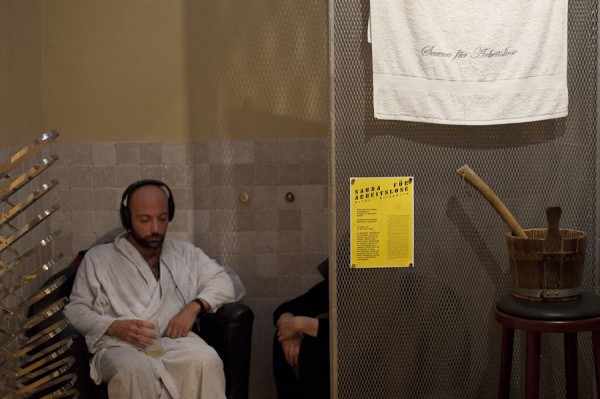
Sauna für Arbeitslose, 2016, Photo: Emma Haugh
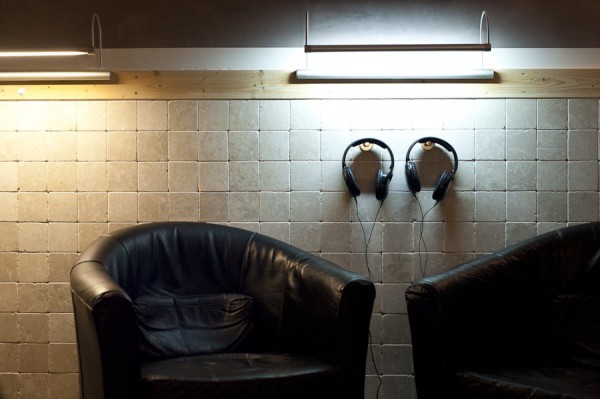
Sauna für Arbeitslose, 2016, Photo: Emma Haugh
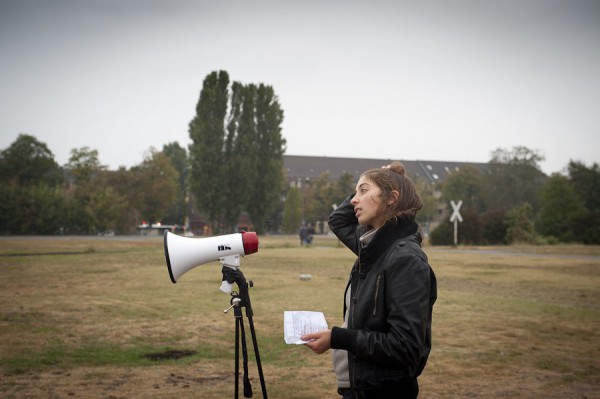
Trümmerberg Kilimanjaro, Kioskkultur, 2016, Photo: Emma Haugh
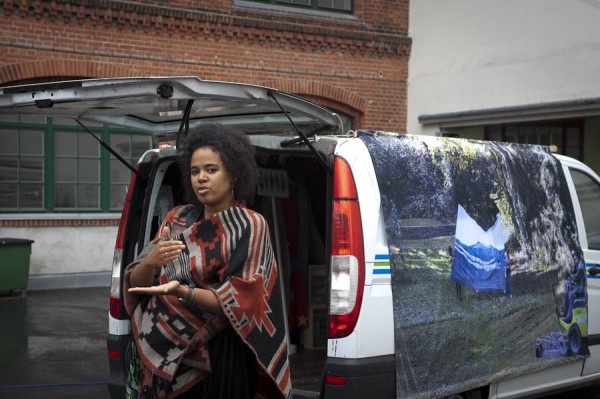
Trümmerberg Kilimanjaro, Kioskkultur, 2016, Photo: Emma Haugh
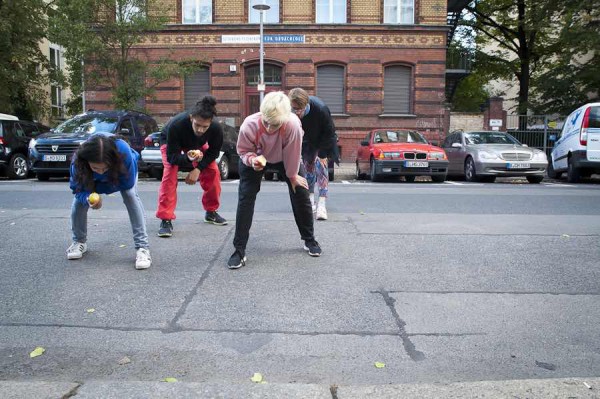
..Über die Pflugstrasse, Gespräche und Performances, 2016, Photo: Emma Haugh
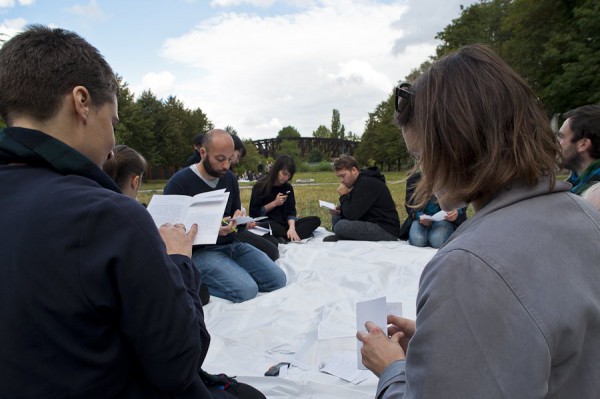
..Über die Pflugstrasse, Gespräche und Performances, 2016, Photo: Emma Haugh
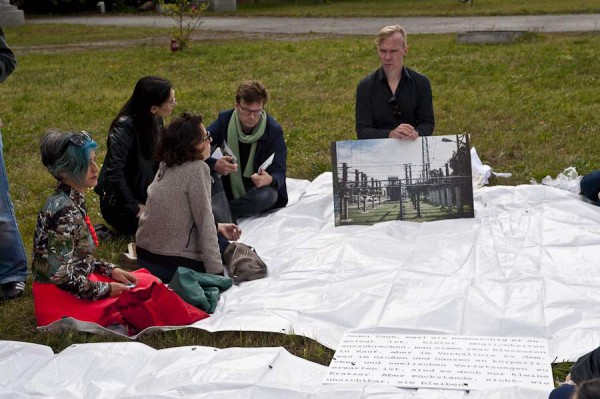
..Über die Pflugstrasse, Gespräche und Performances, 2016, Photo: Emma Haugh
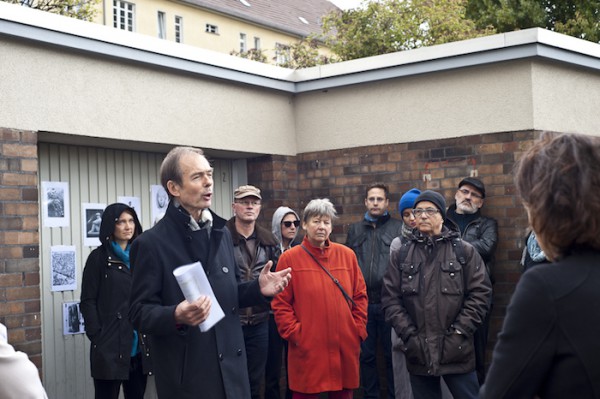
...in der Gartenkolonie, 2016, Photo: Emma Haugh
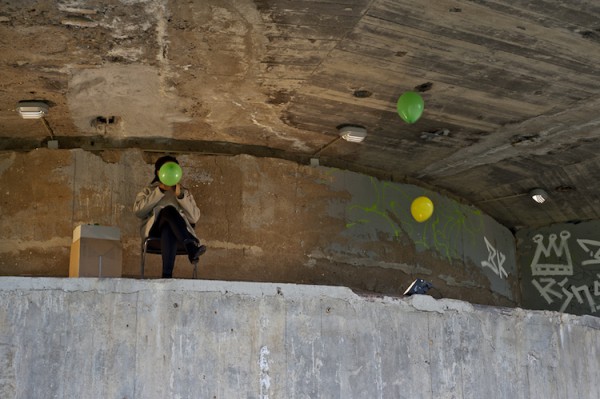
...in der Gartenkolonie, 2016, Photo: Emma Haugh
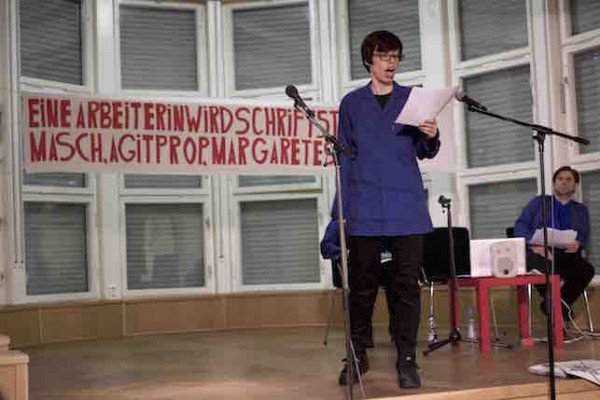
Eine Arbeiterin wird Schriftstellerin, 2016, Photo: Lucrezia Zanardi
1, 2, 3, 8, 15 October 2016
Think of ephemera as trace, the remains, the things that are left, hanging around in the air like a rumor.
José Esteban Muñoz
Undisciplinary Learning: City connects original locations from the book, which are characterized by transformations, traces of political conflicts, or ephemeral encounters, with current emancipatory topographies. The site-specific performances, conversations, and interventions that the artists develop in conversation with contemporary political initiatives, in solidarity with past protest movements, or in anticipation of coming associations will thus become temporary marks on the map of Berlin.
Trümmerberg Kilimanjaro Kiosk Culture Decolonial Archives Tour
1 October, 13–19 h
In the frame of the exhibition TRÜMMERBERG KILIMANJARO, the Kiosk Culture Decolonial Archives Tour investigates the colonial debris that nurtured the economic and political identity of Berlin since the turn of the century. Reconsidering specific spaces in the Tempelhof neighborhood as monuments of colonial memory, Nathalie Anguezomo Mba Bikoro’s and Anaïs Héraud-Louisadat’s ongoing project Squat Monument engages with the experiences of people whose bodies and voices have been made invisible overtime. With the trajectory of the archive through urban space, a decolonial landscape of trade culture and cinema production in the early 20th century is being re-assembled through interventions, film displays, workshops and performances.
Kiosk Culture is inspired by the System of Debrouillardise (after Robert Neuwirth), a term pirated from French-speaking Africa and the Caribbean that translates as ingenuity economy, the economy of improvisation and self-reliance and that draws critical parallels with the histories of resistance movements in cinema in East and West Africa in the 60s and 70s. Cinematic images were on show transiting through rural villages in movable vans to display propaganda colonial films in the 50s. Later colonial opposition movements transformed this specific format into a decolonial method of independence in particular in Namibia, and other former German and Portuguese colonies, by showing their own movies. This would change the political economical landscapes by deconstructing anthropological traditions produced by local migratory and displaced communities to re-assemble spaces of unification.
Kiosk Culture is a moving hub that investigates this strategy in order to re-assemble spaces of unification within the urban migratory spaces of Tempelhof. By turning a van into a performative archive that gathers knowledge, memories and peoples of local communities, the Kiosk attempts to project the anti-thesis of a museum display and to transform our relationship to local space.
Kiosk Culture Decolonial Archives Tour takes its departure from the Museum Tempelhof on the evening of the 30th September, at the occasion of the finissage of their exhibition Squat Monument: Introduction to a Decolonial Atlas.
Based on their research on Marienhöhe and its connection to the making of colonial propaganda movies by the local UFA cinema studios, the artists have reclaimed erased narratives to insert them into the permanent historical exhibition. After a live performance, a procession of objects and artworks will be placed in the kiosk van.
The following day (Saturday 1st of October from 1pm), the movable archival museum tours the neighborhood inviting audiences and passersby to enter in dialogue with the artists and participate in collective actions at 3 stops. The first stop is at Sarotti Höfe, the outlet of the Sarotti chocolate factory, which marketed their products under the logo of the Black Moor since 1918. From Sarotti the Kiosk moves to Tempelhof airport, which was built between 1937 and 1941 and nominated a a aaas a site of aircraft and weapon manufacturing production based on forced labor during National Socialism. In the fields in front of the former airport building the artists offer a kite workshop based on their exploration of decolonial feminists in the anti-colonial resistance movements organized between Berlin, Cameroon and Namibia. The trajectory ends at Nathalie Anguezomo Mba Bikoro’s and Anaïs Héraud-Louisadat’s exhibition Trümmerberg Kilimanjaro within the framework of Undisciplinary Learning. Remapping The Aesthetics of Resistance.
..along Pflugstrasse
2 October, 14–17 h
Conversations and Performances Gespräche und Performances with EXIT Deutschland e.V., Alicia Frankovich, Achim Lengerer within the frame work of Die Ästhetik des Widerstands. Peter Weiss 100, a festival by HAU Hebbel am Ufer (28.9.– 8.10.2016). Conversations in German with whisper translation into English
Meeting point 14 h: Pflugstraße 7
Once a site of violent street fights between national socialists and communists, Pflugstrasse in the novel Aesthetics of Resistance is also a site of the protagonists’ political learning and intimate communication. With a performance by Alicia Frankovich, a public reading rehearsal Achim Lengerer and a conversation with EXIT Deutschland, the site-specific program investigates the actuality of the notion of resistance from artistic and activist perspectives.
In her performance Shine Theory, developed for Undisciplinary Learning, the artist Alicia Frankovich negotiates societal power relations and the development of (self) defense techniques by the state and by individuals. Based on approaches of feminist resistance in the contemporary urban milieu and on a post-human and queer perspectives, Shine Theory attempts to empower bodies within collective constellations in their subjectivity and difference. Broadly sourced and produced gestures, situations and relations of the living sculpture layers multiple contexts in a web of physical relations echoing our current condition and formulating future paths. Giving rise to bold physical assertions, the group of professional dancers as well as non-professionals in sequential choreographic passages engages in changing constructions of community and pluralistic behaviours. Responding to the personas of the participants, the performance interlaces urban sediments of lived histories, group strategies of resistance and positive self-assertion as well as embodied possibilities for inter-subjectivity.
In a new site-specific development of his long-term project Proben zu Peter Weiss \ The Trotsky Rehearsals Achim Lengerer invites visitors to engage with the political effects and operations of language and text. Along with materials, steeming from Lengerers research on Weiss’ play Trotsky in Exile (1970), which provoked literary-political debates within different segments of the left in both parts of Germany and thus ultimately brought Weiss to write The Aesthetics of Resistance, the “Public Reading Rehearsal” will integrates texts from the EXIT archives by people who broke away from the neo-fascist scenes in Germany. Lengerer’s Public Reading Rehearsals are a collective, performative practice for approaching fragments and politics that refer to the leftist reading groups of The Aesthetics of Resistance. At Pflugstrasse a text from 1981 by Christian Geissler—written for radio broadcast in 1981—will be proposed for reading and discussion. Back in time Geissler had been in an epistolary exchange with imprisoned RAF-members in Stammheim discussing The Aesthetics of Resistance.
EXIT Deutschland is an initiative, founded in Berlin in the year 2000 to help people, who wish to break with right wing extremism and build a new life for themselves. Based on the values of personal freedom and dignity members of the initiative confront the mindset and behaviors of right wing extremists. EXIT-Deutschland operates politically independent from government, police, secret service and judiciary. Fabian Wichmann one of the members of the organization will present the work of EXIT-Deutschland and give insight into the worldview of former right-wing extremists as well as the difficulties and strategies interrelated with their exit.
Sauna for the Unemployed, Frida Klingberg
3 October, 18–21 h
Sauna für Arbeitslose is an art project that creates a space for sharing knowledge on social and political environments organized by the ideologies of work. Interrogating and staging three common positions a person can attain in society – employer, employee, and unemployed – two groups of three unemployed persons are employed for having a sauna together. The sauna is a space for relaxation, purification and physical exhaustion but also offers an opportunity for confidant conversations. The job assignment is to sweat and share a conversation about personal experiences and knowledge on the society gained from “being unemployed”. The conversations are recorded and the sweat—a well-known metaphor for hard work and a physical product of labor—is collected on towels.
In September 2016 Sauna für Arbeitslose was realized in Berlin in the frame of Undisciplinary Learning: CITY and in collaboration with Saunabad. The record of the intellectual and physical labor produced by the participants – conversations and sweat collected in towels – built the basis for the site-specific installation at the reading room of the sauna, that can be visited until 19 November.
Frida Klingberg’s interest lies in finding new ways to derive stories from unrepresented positions. Her work aims to initiate exchange on personal experiences and structures that conduce a demand for non-hierarchal ethics. Sauna for the unemployed is a process-based art project that was first realized in Sweden in 2014-2015. The installation resulting from this first edition is on view in the exhibition Undisciplinary Learning: CITY at Disrict.
Production: Kordula Fritze-Srbic; Editing and artistic assistence: Eva Storms
We thank all participants and Sandra Wollgast and the team of Saunabad
..in der Gartenkolonie
8 October, 14–17 h
Performance and on-site visit with Hans Coppi Jr, The Association of Persecutees of the Nazi Regime/Federation of Antifascists (VVN-BdA), Naomi Hennig und Lerato Shadi in the framework of the HAU festival Die Ästhetik des Widerstands. Peter Weiss 100. Conversation in German with whispered translations in English.
Meeting Point 14 h: Schwerbelastungskörper, General-Pape-Straße 34a
As one of the many locations of Aesthetics of Resistance the Berliner garden summerhouse served as a hiding place and conspirative meeting point of illegal resistance activities against the NS-Regime. Undisciplinary Learning links the historic traces of the garden colony—the self-sufficiency of workers and the unemployed, anti-fascist resistance, and German colonialism—with the critical knowledge production of the present:
In this site-specific program, the historic complexity of the commuter belt around the Südkreuz station is interrogated along architectonic figurations of power, oppression, and resistance. Places that make shared memories visible stand at the center of commemorative political and artistic discussions, ranging from everyday struggles to survive and to recount political and artistic insurgencies. The paradoxical proximity of architecture in which the nation violently monumentalizes and inscribes itself in the memory of the city and the semi-permanent garden colony constructions is striking. In the urban garden colonies—which arose around the same time as German colonial endeavors in Africa—the history and present of subsistence and the nuclear family, resistance and alternative conceptions of society, autonomy and Teutomania are equally present.
The beginning and the end of the tour convene at the Schwerbelastungskörper on General-Pape-Straße with Lerato Shadi’s processual performance Hema: Berlin, which lasts several hours. The architectural relic of the National Socialist regime—which marks the southern end of the urban axis of Hitler’s planned “Welthauptstadt Germania” [World Capital Germania] in an area now known as Tempelhof—remains mute on the question on the vital forces of French forced laborers who participated in building an architectural form meant to “measure” the soil of Berlin in 1941. In her performance, the South African artist Lerato Shadi embodies resistance tactics that intervene in dominant, one-dimensional historical narratives in order to represent both the absence and survival of unheard voices. She shifts the knowledge of figures of protest and oppression out of her body and into action with fragile and nonetheless enduring breath.
In a site visit to concrete locations in the former Papestraße Garden colony, the artist Naomi Henning reconstructs forgotten stories entangled within the urban history of Berlin. Henning approaches the political and artistic effect/ work of Kurt Schumacher in dialogue with the historian and Hans Coppi Jr., who witnessed the time period (Coppi is the son of the Hans Coppi portrayed in The Aesthetics of Resistance and chairman of the VVN-BdA, a non-partisan anti-Fascist organization of persecutee relatives of the Nazi regime and opponents of Neo-Nazism and racism). The communist resistance fighter belonged to a network of over 150 participants of different Berlin friends and resistance fighters, among them his wife, the graphic designer Elisabeth Schumacher, and his friend the dancer and sculptor Oda Schottmüller. The group is better known under the name used by the Gestapo “Rote Kapelle (“Red Orchestra”), to which the third volume of The Aesthetics of Resistance refers to.
In the far reaches of the garden colony, on the location where the apartment and the self-timbered studio of the sculptor Kurt Schumacher once stood, the tour will commemorate their artistic works, lives, and death through selected texts, pictures and stories.
The tour will also visit today’s memorial site Papestraße, the only historical site of the early NS-Terror in Berlin, in which traces of the year 1933 can be found. In the former SA-Prison hundreds of Nazi opponents were locked away and tortured.
In conclusion, the tour will lead us back to Lerato Shadi’s performance at the Schwerbelastungskörper.
A worker becomes a writer: MASCH, Agitprop, Margarete Steffin
15 October, 19 h
at Rosa-Luxemburg-Saal, Karl-Liebknecht-Haus
Kleine Alexanderstr. 28, 10178 Berlin – Mitte
Free Entrance
As part of the program Undisciplinary Learning: Remapping the Aesthetics of Resistance CITY, which takes place at original sites from The Aesthetics of Resistance, the artists Rena Rädle & Vladan Jeremić and Ina Wudtke stage a reading of texts from the worker-writer Margarete Steffin at Karl-Liebknecht-Haus. In his novel, Peter Weiss describes workers schools in which young workers discover art and literature for the first time and become artists and writers themselves. Before 1933, Margarete Steffin was a part of worker’s choirs and agit-prop troupes and also wrote agitational lyrics and poems. Steffin met Bertolt Brecht in the Marxist workers school (MASCH), which was founded in Karl-Liebknecht-Haus. Margarete Steffin was Brecht’s closest collaborator in the years from 1933 until her death in 1941. In Brecht’s writing collective, she was responsible for “translating” his texts into “worker’s language.” Brecht and Steffin wrote the most important texts of the German resistance against fascism from exile in Denmark.
Rena Rädle and Vladan Jeremić thematize social resistance and the potential of emancipatory politics through trans-disciplinary research and interventions with texts, parole, drawings, videos, and public actions. In her work as an artist and activist cultural producer (such as her work with the publishing collective that produced the feminist artist magazine NEID from 1992 until 2004), Ina Wudtke questions hegemonic discourses and attempts to strengthen counter-perspectives on subjects like identity, work, the city, and living.
On the evening of A worker becomes a writer: MASCH, Agitprop, Margarete Steffin, alongside Steffin’s work the artists Rena Rädle & Vladan Jeremić and Ina Wudtke introduce their Arbeitsblätter zum lebenden Bild (Worksheets for Tableau Vivant), which they developed as their contribution to the exhibition Undisciplinary Learning. Remapping the Aesthetics of Resistance at District. The free 16-page newspaper engages with agit-prop techniques used by workers movements in the 20s and 30s in Germany, among which belong the nearly forgotten “Tableau Vivant”. The recreation of historical scenes was originally part of the entertainment program of festive events for the aristocracy and bourgeoisie. In the Weimar Republic, communist agit-prop troupes radicalized the Tableau Vivant as a means of protest and direct action. The newspaper shows historical Tableau Vivants and additionally suggests scenarios for Tableau Vivant that respond to the current political situation.








